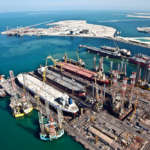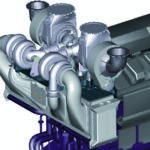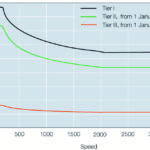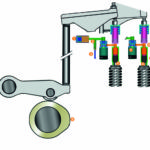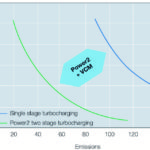High Pressure Turbocharging Puts IMO Tier III in the Crosswire Targeting limits on emissions of oxides of nitrogen (NOx) in the range required by IMO Tier III for ships in Emission Control Areas, ABB Turbocharging has introduced its Power2 two stage turbocharging system.
Pressure ratios around 8
Power2 technology can produce turbocharger pressure ratios high enough to achieve very strong Miller[ds_preview] Cycles on 4-stroke engines. The systems under development consist of two turbochargers of different, tuned frame sizes with the larger turbocharger upstream of the smaller unit. They are connected in tandem on the compressor side via an intermediate air cooler – cooling the compressed air issuing from the first turbocharger means the second turbocharger needs to do less work and can be more compact.
This arrangement readily produces pressure ratios in the range around 8 which promise to achieve high, double digit NOx reductions on 4-stroke medium-speed diesel engines. In fact, latest calculations for Power2’s potential made by ABB Turbocharging’s development engineers, using highly sophisticated simulation software which, over the years, has gained an excellent reputation for its accurate computations, indicate that the 80 % reduction in NOx values via-à-vis IMO Tier I required under IMO Tier III for ships operating in designated Emissions control Areas (ECAs) is already a realistic prospect.
Typically, ABB Turbocharging is not merely at the forefront of efforts to meet IMO Tier III in ECAs using only primary on engine measures, The company is also working on new concepts which promise to not only make a very significant contribution to reducing NOx emissions, but also to engine builders’ other traditional preoccupations: fuel consumption and power density.
Improved air management
These efforts centre on substantially improving air management including increasing the air pressures which can be produced by ABB turbochargers. The first step is the market leading pressure ratios offered by the A100 turbocharger generation, targeting IMO Tier II, to be followed by Power2, while Power2 represents a step change to new levels of pressure ratios. Moreover, ABB’s efforts go yet further in the form of its work on the VCM Valve Control Management system for large four-stroke engines being jointly developed with partner INA Schaeffler, a leading manufacturer of automotive engine components and systems.
Taming the trade-off
The rationale behind all these developments is to assist engine builders to attain the »Miller Cycles« needed to alleviate one of the hitherto most intractable constraints in the search for lower NOx emissions without penalties on the fuel efficiency side: the necessary compromise between NOx emissions and specific fuel consumption (SFC).
The so-called »NOx-SFC Trade-off« reflects the fact that NOx formation reduces with lower combustion temperatures while engine fuel efficiency increases with higher combustion temperatures. Hence, in the early days of emissions reduction on diesel engines, a widespread measure was to reduce combustion temperatures by retarding fuel injection to reduce the rate of heat released from the fuel. Thus a fuel consumption penalty was incurred in the interests of lower NOx emissions.
However, while the trade-off will always be a fact of every engine developer’s life, the findings of ABB and its development partners show that using a combination of much higher turbocharging pressures, VCM, advanced fuel injection technology (e. g. common rail), and electronic control, the Miller Cycle is capable of shifting this compromise between NOx emissions and fuel consumption values into a new, far lower range. Moreover, as stated, a further effect, of the higher turbocharging pressures used is a useful increase in engine power density.
Miller Cycle
These assertions are explained by examination of the Miller Cycle and its effect. The term denotes an ingenious method of cooling an engine’s combustion air and so eliminating high temperature peaks in the engine’s combustion chamber which are responsible for over 90 % of NOx formation.
On 4-stroke engines, the cooling effect is achieved by shortening the opening period of the inlet valve and so reducing the time during which air can enter the cylinder on the engine’s induction stroke. The earlier end of induction promotes expansion, and hence cooling as the air continues to expand.
On 2-stroke engines, where the timing of air induction is the function of the piston passing fixed inlet ports, a similar effect can be achieved by varying the closure of the exhaust valve. In both cases, however, without turbocharging countermeasures, a shorter period for air induction would mean only a reduced mass of air could enter the combustion chamber and engine power output and response to load changes would suffer.
Hence, higher turbocharging pressures are used to compensate the shorter time for induction, allowing an equal – or even greater – mass of combustion air to be forced into the cylinder in the briefer period available. In this way engine power characteristics can be maintained – and bettered – while still achieving significant reductions in NOx formation due to lower combustion chamber temperatures. Significantly, this does not affect the quality of combustion and thus hence need not impair fuel consumption.
Single and two stage high pressure turbocharging
The first generation of IMO Tier II compliant engines, announced since 2008, employ relatively »light« Miller Cycles and, hence, the A100 generation’s pressure ratios of up to 5.8 for four strokes and over 4.7 for 2-stroke diesels are already enabling useful improvements in fuel consumption. Indeed, medium term, the expectation is that on marine engines the A100 generation can help engine builders to both attain a complete elimination of any fuel consumption penalties associated with IMO Tier II whilst also further undercutting its NOx values.
VCM for variable Miller
The strong Miller Cycle described above assumes an engine operating at its best point for power and / or fuel consumption and / or emissions. In the case of a diesel powering a ship this is the so called »maximum continuous rating« (MCR). However, engines have to be started and in many applications »follow the load«, i. e. their output is expected to vary as the work to be done by the engine varies. This is the case in marine propulsion and onboard power generation. At low loads, the short inlet valve timings needed for very strong Miller Cycles on 4-stroke diesels lead to increased smoke emissions due to low combustion temperatures as well as poor response to load changes.
A method is needed to vary the length of inlet valve opening and so allow the time available for combustion air induction to be varied and the strength of the Miller Cycle adapted to engine load and speed. This is the function of the VCM Valve Control Management system ABB Turbocharging is currently developing in cooperation with engine component specialist INA Schaeffler KG. VCM is based on INA’s UniAir system for automotive engines and allows variation of both valve timing and lift on 4-stroke diesel and gas engines in the power range above 400 kW. A prototype of the new VCM system is currently undergoing an extensive test program. First results confirm the system’s potential for highly flexible valve timings on 4-stroke engines.
IPOS
Together, VCM and ABB Turbocharging’s Power2 two stage turbocharging technology form major elements in the company’s IPOS Innovative Power Solutions program. With IPOS, ABB targets unique single source supplier status for two of the major primary systems required on the flexible, low NOx, high efficiency, high power density 4-stroke engines of the future.
A joint development programme
Wärtsilä and ABB Turbo Systems are co-operating in a joint development programme for a new and groundbreaking application of two-stage turbocharging on large diesel engines. Advanced engine technology, together with two-stage turbocharging, offers significant advantages in fuel consumption and engine emissions.
The application of two-stage turbocharging technology on Wärtsilä diesel engines has been developed through close co-operation between Wärtsilä and ABB Turbo Systems. In this programme, Wärtsilä is focusing on developing advanced engine technology, which with the turbocharger, is able to reach the highest possible performance and become a cost-effective commercial solution for its customers. ABB Turbo Systems is delivering the turbocharging technology with defined performance in terms of airflow, pressure ratios and efficiency.
»ABB Turbo Systems is one of Wärtsilä’s main development partners, and has played an important role in Wärtsilä’s product development for more than three decades. Our customers benefit from the productive and successful R&D activities of our two companies, both of whom are leaders in their fields,« says Mikael Troberg, Director of Wärtsilä Testing & Performance.
Benefits of reduced emissions and fuel consumption
In the new engine design, two turbochargers are arranged in series to generate increased air pressure, airflow and a superior turbocharging effect. This results in an efficiency rating of up to 76%, which is extremely high. The increased air pressure, combined with the advanced engine technology, improves the engine output and power density by up to 10 %. At the same time, both fuel consumption and CO2 emissions are reduced.
Further emissions reduction can be achieved with additional engine systems or by the use of exhaust gas after-treatment. A precise combination of fuel consumption levels and reductions in CO2 and NOx emissions can be selected through detailed systems configuration. Intelligent engine control allows optimum operation of the advanced engine design over the whole load range, and a significant reduction in NOx emissions can be reached. At high altitudes, 2-stage turbocharging technology guarantees the engine’s operational performance by compensating for the reduced air density.
The significant reductions in fuel consumption and emissions are the result of extensive joint testing of the 2-stage turbocharging system on the Wärtsilä engine. The tests have taken place at Wärtsilä’s test facility in Vaasa, Finland, and the targets for the development programme have been successfully met. Wärtsilä and ABB Turbo Systems are planning to initiate a major pilot project with a customer in the near future.
Lower lifecycle costs
Another driving factor in this development work has been to significantly lower lifecycle costs, and this target has been met. So too has the goal of lowering NOx emissions. The market potential for this technology in power plants is believed to be big. Similarly, the advanced technology for combustion control developed by Wärtsilä will be beneficial to the shipping market, when the market requirements are in place. Here, in addition to costs, the compactness and cost effective design are considered to be of importance. Calculations indicate that in certain power plant applications, the investment in advanced 2-stage engine technology could be regained in less than two years of operation.
»The conceptual design for the new power plant engine began three years ago,« says Mikael Troberg. »Testing of the concept, and verification of the technology, has been successfully carried out using four-stroke Wärtsilä 20 and Wärtsilä 32 engines. We see this technology as being a key for the next generation of Wärtsilä emissions-friendly engines. The technology has been developed for the four-stroke portfolio, in both marine and power plant applications. The next logical step is the two-stroke engine family for large vessels, typically as single engine installations.«
Cutting emissions – high on everyone’s agenda
Emissions control plays an increasingly important role today, and in particular reducing CO2 and NOx levels is high on the agenda. Today, the market is demanding environmentally sound solutions with competitive lifetime costs. This need continues to pave the way for the introduction of new technologies developed by Wärtsilä and ABB.






